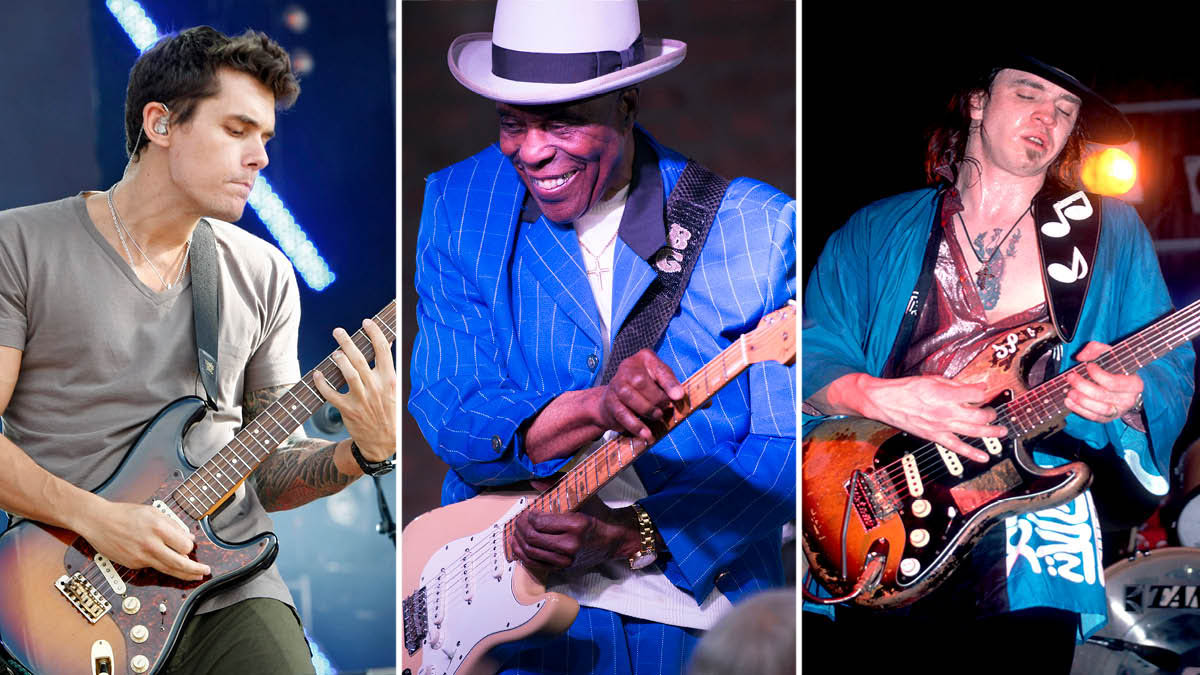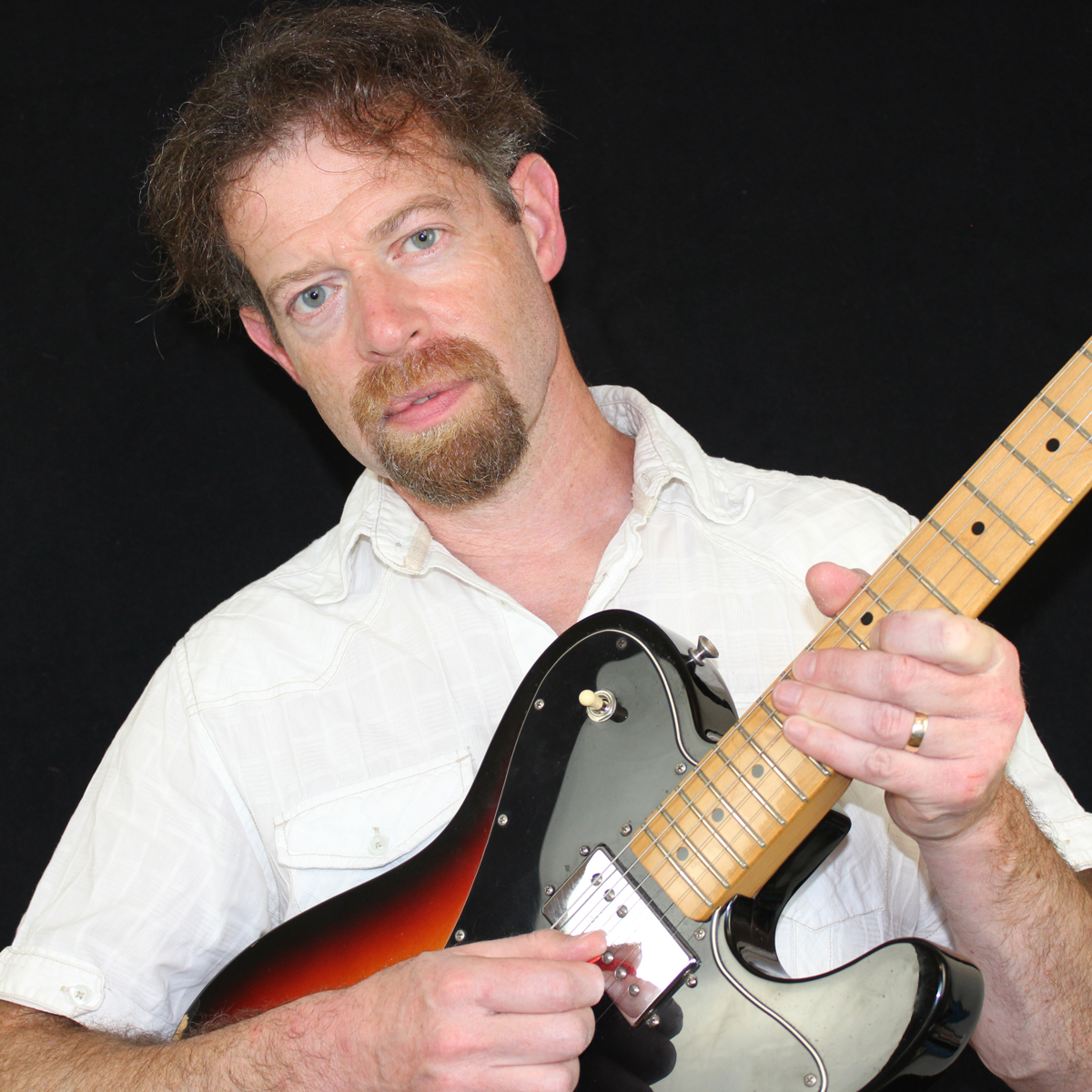Learn the licks of 12 Stratocaster blues legends
Unleash your inner blues guitar hero with these lead ideas in the style of Buddy Guy, Stevie Ray Vaughan, John Mayer, Eric Clapton and more

The Fender Stratocaster is one of the most famous and widely used electric guitars in the history of the instrument. Originally launched in 1954, it had a revolutionary design with its contoured body, three single-coil pickups, six adjustable bridge saddles and ‘synchronised tremolo’.
It has remained largely unchanged ever since, and continues to be played and loved by countless guitarists of all musical walks due to its versatility, sounds and looks.
The ‘Strat’ has always been a highly popular guitar with blues and blues-rock players, and has been synonymous with the careers of several of the most famous and highly regarded players around, such as Eric Clapton, Jimi Hendrix, Rory Gallagher and Stevie Ray Vaughan.
In this lesson, we look at the styles of 12 legendary Stratocaster wielding blues guitar players in the context of six bespoke mini pieces that represent many of their characteristic soloing approaches. The pieces are in different keys and tempos, and have a different feel. They pair up two of the players in each piece, each one taking half of a piece to solo over.
The player combinations are Robert Cray and Eric Clapton, Jimi Hendrix and John Mayer, Kenny Wayne Shepherd and Philip Sayce, Robin Trower and Walter Trout, Stevie Ray Vaughan and Jimmy Vaughan and lastly Rory Gallagher and Buddy Guy; a plethora of incredible individuals that represent the breadth of stunning Strat blues guitarists.
From a note choice perspective, blues players tend to heavily use the pentatonic scale, both minor (root-b3-4-5-b7) and major (root-2-3-5-6) versions as a firm basis, as these scales are the bedrock of the sound of the blues.
Combined with stylistically orientated technical approaches such as bending, legato and blues curls (bending a note – usually the b3rd – up a quarter tone), an endless vocabulary of wonderful blues guitar phrases are uniquely crafted and expressed into the individual styles that we hear when listening to great players.
In terms of guitar sound, you’ll mainly hear in our six pieces an overdriven tube amp type sound of varying degrees, often paired with the addictively smooth, glassy tones of the Stratocaster’s neck pickup which, although only one of many sounds available on the instrument, is one that many blues players love.
Get the tone
Amp settings: Gain 6, Bass 6, Middle 6, Treble 7, Reverb 4
Even though this feature is all about famous Strat players, you don’t specifically need one to play these pieces. Any electric guitar will be fine. An overdrive pedal is very useful to push your amp into overdrive for a thicker or more distorted lead tone. And we always suggest using the guitar’s controls to tame or boost the basic sound. Add a splash of reverb, too.
Example 1. Robert Cray & Eric Clapton
This 17-bar piece is in the key of B minor. The first eight-bar section is the Robert Cray-style solo which uses B minor pentatonic scale (B-D-E-F#-A). The D note (10th fret, first string) on bar 7, beat 1 should be bent up a tone to the E note with the first finger of the fretting hand if possible.
The Eric Clapton-style solo in the next nine bars mainly uses B minor pentatonic but occasionally adds the major 2nd (C# note) for a richer and fuller flavour.
Example 2. Jimi Hendrix & John Mayer
This is another 17-bar piece but in the key of C minor. The first half is the rockier feel Hendrix-style solo. The tone-and-a-half bends from bar 6’s beat 3 into bar 7’s beat 1 on the second string (C note to Eb note) should be accurately pitched, but needs fretting-hand stamina, so be careful of how much you strain.
The John Mayer-style solo in the next half centres around Eb major, and marks the chord changes subtly, but significantly. Pay attention to the accuracy of the second-string bends in the phrase from bar 15 into bar 16. The 8th fret to 10th fret (G note to A note) bend should be fretted with the first finger.
Example 3. Kenny Wayne Shepherd & Philip Sayce
This upbeat piece is a 16-bar blues in the key of F. The first half of the piece is the Kenny Wayne Shepherd-style solo which mainly uses the F minor pentatonic (F-Ab-Bb-C-Eb) but also features the F minor blues scale which adds the b5th (Cb note). Note how the C minor blues scale (C-Eb-F-G-Bb) is briefly used over the C7 chord in bar 7.
The Philip Sayce-style solo in the following half has a tricky opening, especially the lick in bar 10 which has a third-string bend with a sustained fretted high G note (15th fret, first string). The long rapid-fire phrase in bars 11-12 will need to be studied carefully and played slowly at first.
Example 4. Robin Trower & Walter Trout
Here’s another lively 12 bar blues-rock piece, this time in the key of D, with the Robin Trower-style solo first, and the Walter Trout-style solo second. Mainly using D minor pentatonic scale (D-F-G-A-C), the first solo has a tricky and speedy sextuplet phrase in bar 4, which I suggest you play with a downstroke on the first string and an upstroke on the second string.
The multiple bending lick on the third string at the start of the Walter Trout-style solo in bar 7-8 requires accurate pitching, so practise this phrase carefully. The use of the Major 2nd (E note) adds a rather nice, extra melodic flavour to this phrase, too.
Example 5. Stevie Ray Vaughan & Jimmie Vaughan
This is a 12-bar blues in the key of E (with an additional bar at the end for the very last note), which fictitiously reunites the equally amazing but very different Vaughan brothers. Check out the contrast between the guitar sounds here, with the Tube Screamer-driven midrange tones of the Stevie style solo, against the more treble focused sound of the Jimmie-style one.
The bar 9-10 first-string bend lick is tricky, so pay attention here to your pitching. Additionally, the G note (15th fret, first string) bend on bar 10‘s beat 3 of this phrase should be fretted with the first finger if possible.
Example 6. Rory Gallagher & Buddy Guy
This is a 12-bar slow blues in the key of A which mainly uses notes from the A minor pentatonic scale (A-C-D-E-G). Pay attention to your string bending and phrasing accuracy as there are a lot of quite fast passages among the licks. The final note of the Rory-style solo is a C# which is the major 3rd borrowed from the A major pentatonic scale (A-B-C#-E-F#).
The Buddy Guy-style solo also has some tricky sections; the second string should be caught under the fretting finger on the last note of bar 7, and I suggest an upstroke with the picking hand should be used here – be as dissonant and aggressive with this as you like.
Get The Pick Newsletter
All the latest guitar news, interviews, lessons, reviews, deals and more, direct to your inbox!
Andy Saphir has been a professional guitar player and teacher for over 25 years. Graduating with distinction from London’s prestigious Guitar Institute in 1995, he has gone on to gain a reputation as one of the UK’s top country guitarists. Specialising in country and blues, Andy is a versatile, multi-genre player and has a successful international performing career, touring with numerous shows and bands, including the Blues Brothers Approved. Andy taught on the guitar faculty at London’s ICMP for many years, and is a longtime contributor to Guitar Techniques Magazine, as well as being a Jam Track Central artist. Andy teaches in-person guitar lessons from Cambridgeshire UK, or remotely globally.
“I was writing songs from eight years old, but once I got a guitar I began to deeply identify with music… building an arsenal of influences”: How Lea Thomas uses guitars her dad built to conjure a magic synthesis of folk, pop and the ethereal
“I liked that they were the underdogs. It was not the mainstream guitar. It was something that was hard to find”: Vox guitars deserve a second look – just ask L.A. Witch’s Sade Sanchez, who’s teaming hers with ugly pedals for nouveau garage rock thrills








![Joe Bonamassa [left] wears a deep blue suit and polka-dotted shirt and plays his green refin Strat; the late Irish blues legend Rory Gallagher [right] screams and inflicts some punishment on his heavily worn number one Stratocaster.](https://cdn.mos.cms.futurecdn.net/cw28h7UBcTVfTLs7p7eiLe.jpg)


